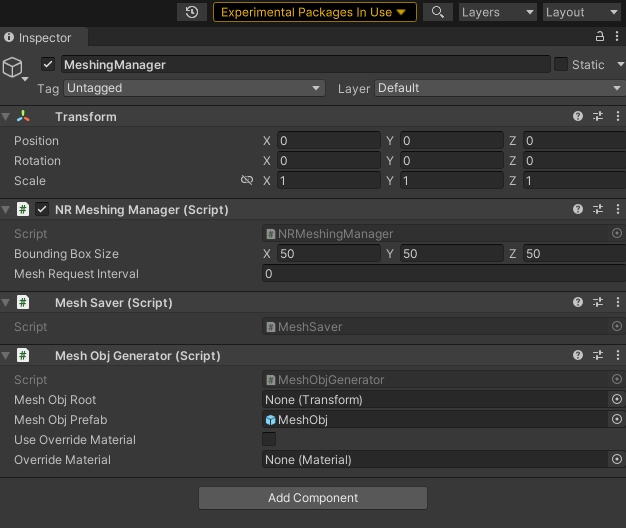Tutorial: Mesh Collision
What you'll build
In this tutorial, we will enable meshing and demonstrate how to collide objects with the generated mesh.

What you'll need
This tutorial assumes you have a working Unity scene with the NRSDK imported. Please refer to the Getting Started with NRSDK page for more details on how to import the NRSDK package.
1. Create a new scene
create a new folder named MeshCollsion, and another folder named Scene, and then create a new scene named MeshCollsion.

Add the NRCameraRig and NRInput prefab into the hierarchy.

2. Add the MeshingManager
Create an empty GameObject called MeshingManager.

Add the following scripts to Meshing Manager:
NRMeshingManager.cs
MeshObjGenerator.cs

3. Add a sphere
Right-click on the scene hierarchy and click Game Object> 3D Object> Sphere.

Click on the sphere and set its size to 0.05.
Then add a rigid body component to the sphere. This tells Unity to give the sphere physics properties so it will fall down unless it hits something. You can also apply forces to it to move it around, simulate throwing it, etc. Note that if you don't change the Collision Detection to Continuous Dynamic, sometimes your ball will pass directly through the mesh, with no collision effect.
Add a material to the sphere to make it more obvious.

Create a folder called Prefabs, and drag the sphere to the folder.

4. Add code to shoot the sphere
Each time the user taps the touchpad, a ball will be shooted in place of the ray cast from the phone's controller.
By attaching the following script to NRCameraRig, you can customize the shoot position of the sphere. This tutorial uses the ray cast position, Model Anchor, as the emission point.
Set the prefab Sphere you just made as the Ball Prefab.


5. Destroy the sphere after a period of time
To save scene resources, use the invoke function to destroy the sphere after a specified time.
Attach the script to the sphere prefab made in Step 3.
6. Build and Run
Was this helpful?